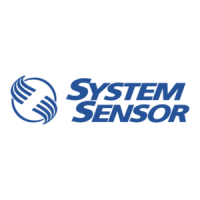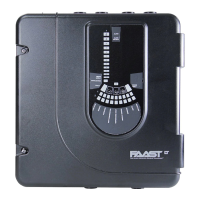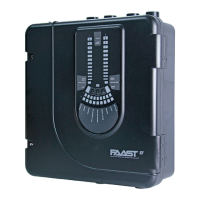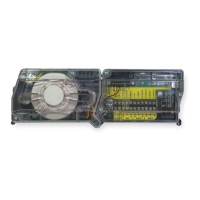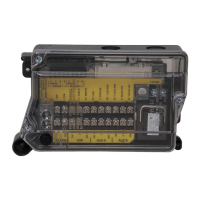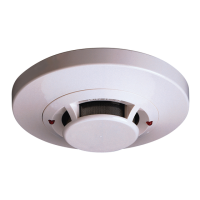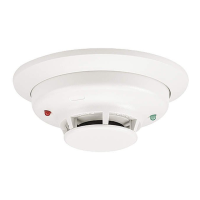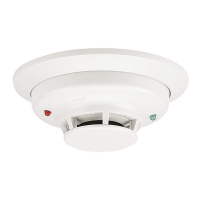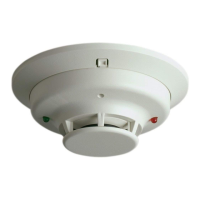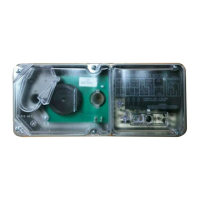Installation / Alignment
Reference Figures 10 through 14 for installation, alignment,
and maintenance.
The alignment of the FSB-200/FSB-200S is divided into four
steps: coarse alignment, fine adjustment, final gain adjust-
ment, and final verification. It is necessary for all four
steps to be executed properly to ensure proper alignment
of the product. If the detector and reflector are mounted per
Mounting Locations and Mounting Instructions sections of
this manual and the alignment procedures are executed
properly, false alarms and nuisance trouble signals will be
minimized.
Pre-Alignment Checklist
• Insure that both the detector and reflector are mounted
securely to stable surfaces.
• Insure that all wiring is correct.
• Insure that terminal blocks are fully seated into their
receptacles on the detector.
• Complete any wiring dressing to minimize movement
to the detector once the alignment procedure is com-
pleted.
• Insure that the appropriate number of reflectors are
used for the installed distance. Distances between 230
& 328 Feet (70 - 100m) require additional reflectors (4
total). The BEAMLRK accessory should be used in these
cases.
• Insure that the line of sight between the detector and
reflector is clear and that reflective objects are not too
near. See Mounting Instructions for more details.
• Insure that both the detector and reflector are mounted
within their operational parameters for off axis angles.
See Mounting Instructions for more details.
• Disable the zone or system to prevent unwanted alarms
before applying power.
• Insure power to the detector is “ON”.
• Insure that the appropriate address is set on the code
wheels.
You are now ready to begin the alignment procedure.
Step 1. Coarse Alignment
Refer to Figures 11 and 12 for this step.
1. Insure that both of the optics lock-down screws are loos-
ened so that the optics will move freely.
2. Looking through the alignment mirror at both the align-
ment sight and reflector simultaneously locate the posi-
tion of the reflector in the optical sight. This step will
require some practice. It is necessary to train your eyes
to shift focus between the reflector and the mirror in
order to locate the reflector. If the distance between the
reflector and the detector is large it is helpful to place a
brightly colored object on the wall near the reflector to
aide in seeing the reflector in the alignment mirror.
3. Once the reflector has been located, begin to adjust both
the horizontal and vertical alignment knobs so that the
reflector becomes centered in the alignment mirror. Take
care in this step. If the optics are incorrectly aligned in
this step, it will not be possible to proceed with the fine
adjustment step.
Step 2. Fine Adjustment
Refer to Figures 10 through 12 for this step.
In this step you will be fine-tuning the optics to the reflec-
tor. To provide feedback of the signal level coming from the
reflector the dual digital display readout will be used. Due
to the large distance range that the detector can operate
over it is necessary that the detector operate with many dif-
ferent settings of “electronic amplifier gain”. The detector
is capable of determining the appropriate gain setting and
then setting it itself via on-board processing algorithms.
There are no external gain settings on the detector that
must be set by the operator. Periodically throughout the
fine adjustment step the detector will need to re-adjust its
“electronic amplifier gain” setting. When this occurs it will
be indicated by the dual digital readout as “- -”. When this
occurs, cease any further adjustment until the display again
reads a number value.
1. Insure that neither you nor any other objects are in the
line of sight between the detector and the reflector.
2. Depress the Alignment switch once. Both the digital dis-
play and the yellow LED should turn on indicating that
alignment mode has been entered. The display should
begin reading “- -” signifying an electronic gain adjust-
ment. After a few moments the display will indicate a
numeric value near 20. If the display reads “Lo” then
the detector is not receiving enough light from the reflec-
tor. Go back and repeat the course alignment step and
verify that the proper number of reflectors is used for the
installed distance.
NOTE: The display will continue to read “Lo” until the
detector receives enough light from the reflector to
continue with the fine adjustment step.
NOTE: In alignment mode (indicated by the yellow LED
and the numeric display) the sensitivity select and
test switches are disabled.
3. With the display reading a numeric value, begin adjust-
ing the horizontal and vertical alignment knobs one at
a time in the direction that increases the numeric signal
level on the display. Continue adjusting each axis one
N200-25-00 8 I56-2424-04R
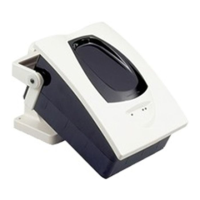
